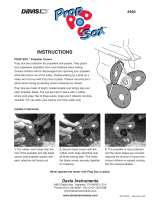Page is loading ...

INSTRUCTIONS
#144
The Davis Artificial Horizon is a device for taking
sun or moon shots with a sextant without observing
the natural or sea horizon. This instrument is particu-
larly useful to students of celestial navigation or expe-
rienced navigators who wish to practice taking accu-
rate shots without having to go to a large body of
water. Observations can be made inland or through a
window of your home. Use for backyard practice, find-
ing exact position when inland, and making exact
sextant shot on foggy mornings. The Artificial Horizon
is actually more accurate than a natural horizon.
Windproof and corrosion resistant, the reflecting
surface is completely enclosed. Comes with two sun
shades and a lid.
Compact size: 6 × 4 × 1½" (15 × 10 × 4 cm).
ASSEMBLY
Lift the lid from the horizon bowl and remove the
side pieces and horizon shades. Fill the bowl with
water or a more viscous liquid. The depth of the liquid
is not important to the accuracy of your sextant read-
ing. If the sun is close to the horizon, however, the
bowl will need to be nearly filled in order to obtain a
reading.
Now erect the side pieces by fitting them onto the
sides of the bowl. These hold the horizon shades and
also act as a windbreak to prevent ripples on the water
surface.
Next choose the horizon shade arrangement to fit
your needs. The two plastic shades, when used
together, darken the sun’s reflection so that the reflec-
tion may be observed directly without use of your
sextant’s horizon shades.* However, if the sun is suf-
ficiently low on the horizon, if you are taking your shots
at night, or if you prefer to use your sextant’s horizon
shades, you may use any combination with the glass
windows included.
* CAUTION: Looking at the sun’s reflection without
sufficiently shading the image can cause eye damage.
USE INSTRUCTIONS
Fill the bowl with water or a more viscous liquid and
place it on a table or on the ground so that the sun is
directly facing one end. This can be done by moving
the Artificial Horizon until it casts a shadow only at the
opposite end (the sides and end facing the sun being
shadow free).
Now stand or sit in such a position that you can see
the sun’s reflection on the liquid surface. Sight through
your sextant until you have placed this reflection
where the real horizon would normally appear on your
instrument.
Move the index arm of your sextant until the double-
reflected image of the sun on the mirrors of your sex-
tant is brought into coincidence with the reflection on
the liquid.
In the case of the sun or moon, the bottom of the
double-reflected image is brought into coincidence
Make exact sextant
shots on foggy
mornings
Take moon shots
without observing
the natural horizon
Practice making
accurate shots with-
out a body of water

144_WEB-B September 2023
with the top of the image on the liquid for a lower limb
observation. For an upper limb observation, the oppo-
site sides are brought into coincidence. If one image is
made to cover the other, the observation is of the cen-
ter of the body.
When the observation has been made, apply the
index correction. Then take half the remaining angle
and apply all other corrections except dip (height of
eye) correction, since this is not applicable.
Since the Artificial Horizon doubles your sextant
reading, the maximum altitude which can be observed
is equal to one-half the maximum arc graduation on
your sextant. Thus, observations of the sun should
normally be planned for morning or evening, as there
may be several hours near noon when the sun will be
too high.
The Artificial Horizon doubles
your sextant reading.
Davis Instruments
3465 Diablo Ave., Hayward, CA 94545 U.S.A.
Phone (510) 732-9229 • Fax (510) 732-9188
www.davisinstruments.com
/







